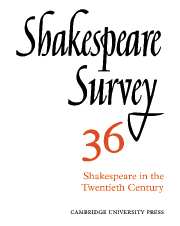Book contents
- Frontmatter
- Shakespeare and the Living Dramatist
- Blood and Wine: Tragic Ritual from Aeschylus to Soyinka
- Hamlet Andante/Hamlet Allegro: Tom Stoppard’s Two Versions
- Auden, Shakespeare, and the Defence of Poetry
- Graves on Lovers, and Shakespeare at a Lovers’ Funeral
- Tragic Balance in Hamlet
- Hamlet Across Space and Time
- Shakespeare’s Scripts and the Modern Director
- ‘He Shall Live a Man Forbid’: Ingmar Bergman’s Macbeth
- Komisarjevsky at Stratford-upon-Avon
- Troilus and Cressida and the Definition of Beauty
- The Pastoral Reckoning in Cymbeline
- New Created Creatures: Ralph Crane and the Stage Directions in The Tempest
- Arden of Faversham
- ‘Pickleherring’ and English Actors in Germany
- Shakespeare Performances in Stratford-upon-Avon and London, 1981–2
- The Year's Contributions to Shakespearian Study 1 Critical Studies
- 2 Shakespeare’s Life, Times and Stage
- 3 Textual Studies
- Index
- Plate Section
New Created Creatures: Ralph Crane and the Stage Directions in The Tempest
Published online by Cambridge University Press: 28 March 2007
- Frontmatter
- Shakespeare and the Living Dramatist
- Blood and Wine: Tragic Ritual from Aeschylus to Soyinka
- Hamlet Andante/Hamlet Allegro: Tom Stoppard’s Two Versions
- Auden, Shakespeare, and the Defence of Poetry
- Graves on Lovers, and Shakespeare at a Lovers’ Funeral
- Tragic Balance in Hamlet
- Hamlet Across Space and Time
- Shakespeare’s Scripts and the Modern Director
- ‘He Shall Live a Man Forbid’: Ingmar Bergman’s Macbeth
- Komisarjevsky at Stratford-upon-Avon
- Troilus and Cressida and the Definition of Beauty
- The Pastoral Reckoning in Cymbeline
- New Created Creatures: Ralph Crane and the Stage Directions in The Tempest
- Arden of Faversham
- ‘Pickleherring’ and English Actors in Germany
- Shakespeare Performances in Stratford-upon-Avon and London, 1981–2
- The Year's Contributions to Shakespearian Study 1 Critical Studies
- 2 Shakespeare’s Life, Times and Stage
- 3 Textual Studies
- Index
- Plate Section
Summary
The stage directions in The Tempest are amongst the best known and the least understood of those in Shakespeare’s works. This paper suggests that, far from reflecting Shakespeare’s genius, the very eloquence of some of their phrasing is part of the evidence for the intervention of a second hand. The obvious candidate for such part-authorship of the stage directions is Ralph Crane, the scrivener to the King’s Men. He acted as scribe in the preparation of several play transcripts, including, it is believed, the copy from which the First Folio text of The Tempest (F) was set up. The theory that Crane intervened suggests that Shakespeare’s original directions were substantially different from those found in F. It therefore opens the way for a reappraisal of both the nature of the copy from which Crane himself worked and the way in which Shakespeare intended some of his most spectacular scenes to be staged in the theatre.
One explanation sometimes offered for the elaborate detail of these stage directions is that Shakespeare was working in semi-retirement at Stratford, and that the fullness of the directions remedies his inability to direct the players verbally. Informative and detailed directions, however, are common in his later plays, and they reach their most extended and elaborate forms not in The Tempest but in the Shakespearian directions in The Two Noble Kinsmen and Henry VIII? As we believe Shakespeare was collaborating with Fletcher in these plays, there is little likelihood that he was in Stratford while doing so. What is indicated is in part a change in his way of writing stage directions, as witnessed, for example, by those in Coriolanus, and in part the increasing prevalence of spectacular, ceremonial, and masque-like elements in the late plays.
- Type
- Chapter
- Information
- Shakespeare Survey , pp. 107 - 120Publisher: Cambridge University PressPrint publication year: 1983
- 6
- Cited by



